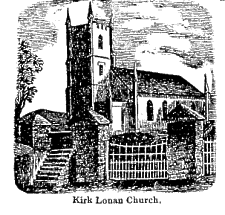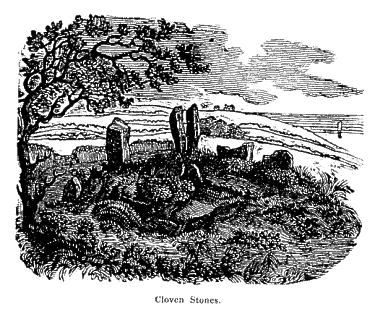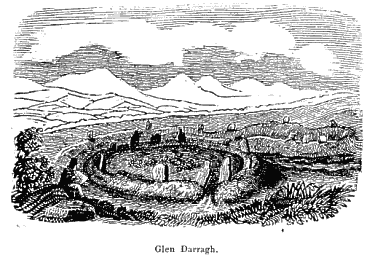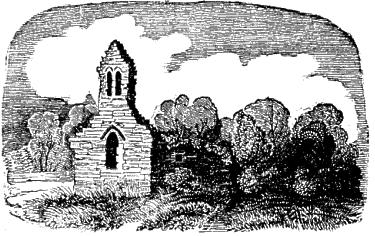[From Quiggin's Guide, 1841]
LAXEY
is a village of little trade, it is in the parish of Kirk
Lonan.
 A
new church in the early style of English architecture, with a tower
surmounted by a spire, with 500 sittings, has been erected about half
a mile from this village. The glen is deserving of notice from the
romantic beauties of its scenery; about half-way up the glen is the
Laxey mine: the vein, running nearly north and south, contains copper
ore, lead ore rich in silver, varying from 80 to 120 ounces in the
ton of lead, and a great body of black jack or blende, and is now
producing about 50 tons of lead ore per month, a quantity of which
lately fetched £26 per ton. There is also a paper mill well and
actively employed. The bay affords convenient anchorage and partial
shelter for small vessels. On the coast oysters and lobsters are
taken. Not far from Laxey, on the road to Douglas, is a Druidical
tomb or altar; it is composed of twelve stones, two of which, about
six feet high, are rent or cloven from top to bottom; tradition
records these stones to have been the grave of a Welch Prince, who
having landed at Laxey, on his invasion of the Island, was slain by
the natives and buried on the spot he fell.
A
new church in the early style of English architecture, with a tower
surmounted by a spire, with 500 sittings, has been erected about half
a mile from this village. The glen is deserving of notice from the
romantic beauties of its scenery; about half-way up the glen is the
Laxey mine: the vein, running nearly north and south, contains copper
ore, lead ore rich in silver, varying from 80 to 120 ounces in the
ton of lead, and a great body of black jack or blende, and is now
producing about 50 tons of lead ore per month, a quantity of which
lately fetched £26 per ton. There is also a paper mill well and
actively employed. The bay affords convenient anchorage and partial
shelter for small vessels. On the coast oysters and lobsters are
taken. Not far from Laxey, on the road to Douglas, is a Druidical
tomb or altar; it is composed of twelve stones, two of which, about
six feet high, are rent or cloven from top to bottom; tradition
records these stones to have been the grave of a Welch Prince, who
having landed at Laxey, on his invasion of the Island, was slain by
the natives and buried on the spot he fell.

That it has been a sepulchral monument there can
be no doubt, as human bones have been dug up from within the stones.
A little further up the river there is fine specimen of an ancient
forti-fled hill.
The next place you arrive at worthy of notice is
KIRK ONCHAN,
pleasantly situated about two miles from Douglas : the high
grounds commanding interesting and extensive views of the bay and
harbour of Douglas. The eye delighted roves over the vast expanse of
water, a(imn~es it under all its fluctuations, and observes
"When calm,
What iris hues of purple, green, and gold,
Play on its glassy surface; and, when vext
With storms, what depth of billowy shade, with light
Of curling foam contrasted"
The vicarage is in the gift of the Crown. A new church, with a
tower surmounted by a Spire, and capable of holding 500 sittings, has
lately beers erected, the Rev. F. Craine, Vicar.
Whether the high or the Shore road to Douglas be
taken from hence, every thing will be found described in the second
day’s perambulation.
Having made the circuit of the Island, there remains now only the
parish of Marown, which lies between Douglas and St. John’s, to
be noticed, part of the road to which, as far as Kirk Braddan church,
has been described in page 72.

About half a mile beyond the church-yard are the Union Mills,
where good woollen cloths are manufactured; in pursuing the
left-hand-road at these mills, the visitor will arrive at the
northern acclivity of Mount Murray, on which is Glen Darragh, where
the most perfect remains of a Druidical temple on the Island are to
be found; it is formed of stones of moderate size placed erect and at
regular distances, enclosing a circle fourteen yards in diameter; on
each side is a stream of water issuing from fountains about fifty
yards higher up the mountain, which by the Druids were held sacred;
to the east of the enclosure are two walls or mounds constructed of
stones and earth, bending round the temple forming a semicircle,
about five yards distant from each other; the spot of ground on which
these remains are situated is barren, bleak, and uncultivated, but
from the name Glen Darragh, which in the Manks language signifies the
Vale of Oaks, it would appear that it was originally planted with
those trees, which the Druids held in great veneration.
A short distance from the Union Mills on the right,
is Ballavar, Mrs. How’ard; and a little further, upon the hill,
is Ballafreer, Mrs. Kewley; nearly opposite the fourth mile-stone, in
the meadow, is Ballaquinnea, a well cultivated farm, occupied by J.
Miller, Esq.; and some distance above that is Ellerslie, the
residence of Mr. Faulder; above which is seen Marown Church, a
vicarage in the gift of the Crown. Between the fourth and fifth
mile-stone is Eyreton,
the property of Mrs. Eyres, and on the left Crosby Chapel. A little
beyond the half way house to Peel on the right, are the ruins of an
old Church dedicated to St. Ninian, or Trinian, built sometime
between A.D. 1270, and 1344.

St Trinian's Church
Near the sixth mile stone, is Northop, the
residence of W. Beckwith, Esq. beyond Greeba mountain to the right,
is Banff Place, Mrs. Bonnyman; a little further on is Norfolk Place,
the seat of Dr. Burman; and about a mile beyond that is Ballacraine,
the Cross-four-ways. [From this place the visitor will find the
road to Ramsey described in page 105.]
ANTIQUITIES.
All the remnants of antiquity there are to be found on the Island
have been noticed as the rout round it has been pursued: they
consist
1st., chiefly of Mounds of Earth, which are thought to have been
thrown up for judicial purposes; the present Tynwald Mount is one so
used to the present day.
2d. Cairns, or circular heaps of stones, supposed to be burying
places.
3d. Long stones set end-ways; of these many occur; they are thought
to be of Danish origin, and that they were meant to perpetuate the
memory of some warrior or some warlike events.
4th. Stones placed circular ly; these are conjectured to be places of
worship, though Professor Thorlekin conceives them to have been used
as civil courts of justice.
5th. Keils or Kirks: these consist of a small enclosed area occupied
with graves, in the centre of which are the ruins of the ancient
church, generally of a quadrangular form, and of diminutive
proportions.
6th. Fortified Hills, of which that at Castleward, quarter of a mile
to the right of Kirk Braddan Church, is a fine specimen.
POPULATION
By a census taken
in 1831, this Island contaias 40,985 inhabitants, distributed as
follows: in the towns,—Douglas, 6786; Castletown, 2062; Ramsey,
1754; Peel, 1729. In the Parishes,—German, 1791; Patrick, 2195;
Marown, 1216; Onchan, 1482; Braddan, 1927; Santon 798; Malew, 2778;
Arbory, 1511; Rushen, 2732; Michael, 1317; Jurby, 1097; Ballaugh,
1411; Bride, 1039; Ayre, 1979; Andreas, 2217; Maughold, 1341; Lonan,
1823.
LANGUAGE
[mostly
erroneous]
The ancient Gaëlc, or Gaulish, spoken by the original
inhabitants is still spoken in the Island, and which was spoken all
over Europe and Asia Minor upwards of 2000 years ago. The very
language spoken by Saturn and Jupiter, who were no gods, but mighty
warriors, mortal men, is the vernacular language of the Isle of Man.
Should the reader feel any thing of unbelief arising relative to the
fact which is here stated, let him consult Pezron, on "The
Antiquities of Nations, &c.," preface xix, and there he will find
the matter clearly proved. We find the ancient Celtic language
divided into two dialects :—the ancient Gaëlc, or Gaulish,
spoken by the Southern Celtae, or Gauls, and that spoken by the
Northern Celtae, or Cimbri, and which the Welch, their descendants,
denominated the Cymraey. From the ancient Gaulish is derived the
Manks Gaëlc; the Hibernian Gaële, spoken in the West of
Ireland, and the Hebridian and Caladonian Gaëlc, spoken in the
Western Isles, and Highlands of Scotland. The Armorican or Bas
Bretagne is another variation of the ancient Gaëlc, and spoken
by a part of the inhabitants of Brittany in France. The Basque, or
Biseayan is another dialectical variation, it was spoken to a small
extent in Spain, and also the Waldensie spoken by the ancient
Waldenses. If the scale of this work were more extensive, the reader
would be furnished with the Lord’s prayer in Waldensic, that the
Manks scholar might see its near affinity to Chengey ny Mayrey
Ellan Vannin. Several places in the Island retain the Norwegian
names imposed upon them when the Island was conquered by the Kings of
Norway; for instance, Jurby, Sulby, Greeby, Scroundhll, Norrisdhll,
Carradhll, Smeayll, which is the name of the highest mountain on the
Island.
 A
new church in the early style of English architecture, with a tower
surmounted by a spire, with 500 sittings, has been erected about half
a mile from this village. The glen is deserving of notice from the
romantic beauties of its scenery; about half-way up the glen is the
Laxey mine: the vein, running nearly north and south, contains copper
ore, lead ore rich in silver, varying from 80 to 120 ounces in the
ton of lead, and a great body of black jack or blende, and is now
producing about 50 tons of lead ore per month, a quantity of which
lately fetched £26 per ton. There is also a paper mill well and
actively employed. The bay affords convenient anchorage and partial
shelter for small vessels. On the coast oysters and lobsters are
taken. Not far from Laxey, on the road to Douglas, is a Druidical
tomb or altar; it is composed of twelve stones, two of which, about
six feet high, are rent or cloven from top to bottom; tradition
records these stones to have been the grave of a Welch Prince, who
having landed at Laxey, on his invasion of the Island, was slain by
the natives and buried on the spot he fell.
A
new church in the early style of English architecture, with a tower
surmounted by a spire, with 500 sittings, has been erected about half
a mile from this village. The glen is deserving of notice from the
romantic beauties of its scenery; about half-way up the glen is the
Laxey mine: the vein, running nearly north and south, contains copper
ore, lead ore rich in silver, varying from 80 to 120 ounces in the
ton of lead, and a great body of black jack or blende, and is now
producing about 50 tons of lead ore per month, a quantity of which
lately fetched £26 per ton. There is also a paper mill well and
actively employed. The bay affords convenient anchorage and partial
shelter for small vessels. On the coast oysters and lobsters are
taken. Not far from Laxey, on the road to Douglas, is a Druidical
tomb or altar; it is composed of twelve stones, two of which, about
six feet high, are rent or cloven from top to bottom; tradition
records these stones to have been the grave of a Welch Prince, who
having landed at Laxey, on his invasion of the Island, was slain by
the natives and buried on the spot he fell. 

